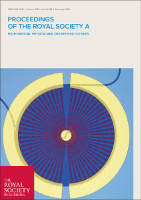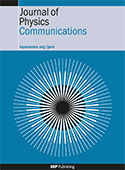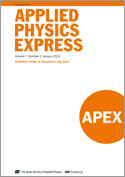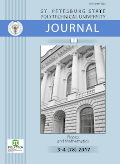
TECHNICAL PHYSICS LETTERS
Scope & Guideline
Exploring New Dimensions in Scientific Research
Introduction
Aims and Scopes
- Applied Physics and Engineering:
The journal covers a wide range of topics in applied physics, including developments in materials science, nanotechnology, and engineering applications of physical principles. - Mathematical and Computational Modeling:
There is a significant focus on mathematical modeling and computational methods to solve complex physical problems, particularly in fluid dynamics, thermodynamics, and materials behavior. - Interdisciplinary Research:
The journal encourages interdisciplinary approaches that combine physics with other scientific domains, such as biology, chemistry, and environmental science, highlighting the interconnectedness of scientific inquiry. - Emerging Technologies:
Research on emerging technologies, particularly in the fields of quantum computing, nanotechnology, and advanced materials, is a core area of focus, reflecting the journal's commitment to contemporary scientific advancements. - Experimental Techniques and Methodologies:
The journal emphasizes innovative experimental techniques and methodologies that contribute to the advancement of physics research, including new diagnostic tools and measurement techniques.
Trending and Emerging
- Nanotechnology and Nanomaterials:
There is a marked increase in research related to nanotechnology, particularly in the development and application of nanomaterials for various technological advancements, including electronics and medicine. - Quantum Computing and Information:
Emerging studies in quantum computing and quantum information science are gaining momentum, reflecting the transformative potential of quantum technologies in various fields. - Biophysics and Biomedical Applications:
Research at the intersection of physics and biology, particularly in biophysics and biomedical applications, is trending, highlighting the relevance of physics in solving complex biological problems. - Advanced Materials and Coatings:
A surge in studies related to advanced materials, including smart materials and coatings, is evident, driven by the demand for innovative solutions in various industries. - Machine Learning and Artificial Intelligence in Physics:
The incorporation of machine learning and AI techniques in physics research is becoming increasingly prominent, indicating a shift towards data-driven science and enhanced computational capabilities.
Declining or Waning
- Classical Mechanics Applications:
Research focused on classical mechanics, particularly in traditional applications, appears to be declining as more complex and interdisciplinary approaches gain favor. - Low-Dimensional Materials:
The exploration of low-dimensional materials, such as quantum dots and nanowires, has seen a decrease in publications, possibly due to a shift towards more complex nanostructures and hybrid materials. - Thermal Analysis Techniques:
Studies centered solely on thermal analysis techniques, while still relevant, are becoming less frequent as integrated approaches that combine thermal properties with other physical characteristics gain traction. - Traditional Semiconductor Physics:
The focus on traditional semiconductor physics has waned, with researchers increasingly exploring novel materials and structures that extend beyond conventional semiconductors. - Electromagnetic Theory in Isolation:
Research on electromagnetic theory, when not integrated with practical applications or interdisciplinary studies, has seen a reduction in submissions, reflecting a broader trend towards applied research.
Similar Journals

Revista Cubana de Fisica
Fostering Collaboration Among Latin America's Brightest MindsRevista Cubana de Fisica is a prominent open-access journal based in Cuba, published by EDICIONES CUBANAS. With its ISSN 0253-9268 and E-ISSN 2224-7939, this journal has been dedicated to advancing the field of Physics and Astronomy since its transition to open access in 2005, making high-quality research readily available to a global audience. Despite its current Scopus rank of #229 out of 243 in the genre, placing it in the 5th percentile, the journal remains a vital platform for disseminating innovative studies and findings, particularly within the broader scientific community in Latin America. Covering a diverse range of topics in physics, the magazine aspires to foster collaboration among researchers, students, and professionals alike, thus bridging the gap between theoretical exploration and practical application. The journal operates under the ambitious objective of contributing to the advancement of scientific knowledge from 2011 to 2024 and beyond, reinforcing its commitment to addressing contemporary challenges in physics and fostering a vibrant academic culture.

CHINESE PHYSICS LETTERS
Innovative Insights in Physics and AstronomyChinese Physics Letters is a prestigious journal published by IOP Publishing Ltd, based in the United Kingdom. Since its inception in 1984, the journal has served as a vital platform for disseminating impactful research in the field of physics, achieving a noteworthy Q1 ranking in the category of Physics and Astronomy (miscellaneous) as of 2023. Renowned for its rapid publication process, this journal is dedicated to providing a forum for high-quality, concise articles that address innovative theoretical and experimental findings relevant to both the academic community and industry practitioners. With an impressive Scopus rank of #52 out of 243, placing it in the 78th percentile, Chinese Physics Letters continues to influence the global physics landscape. Researchers, professionals, and students alike find this journal indispensable for staying abreast of the latest developments and trends in physics.

PROCEEDINGS OF THE ROYAL SOCIETY A-MATHEMATICAL PHYSICAL AND ENGINEERING SCIENCES
Fostering Interdisciplinary Excellence in Mathematical and Physical Sciences.PROCEEDINGS OF THE ROYAL SOCIETY A-MATHEMATICAL PHYSICAL AND ENGINEERING SCIENCES is a prestigious academic journal published by the Royal Society in the United Kingdom, dedicated to the dissemination of high-quality research in the fields of Mathematics, Engineering, and Physics. With an esteemed impact factor and ranked in the top quartiles (Q1) across various categories, this journal stands out as a leading source of innovative findings and critical discussions within the global scientific community. Researchers benefit from its comprehensive coverage that spans from theoretical explorations to practical applications, and the journal plays a crucial role in advancing knowledge and fostering interdisciplinary collaboration. Although it does not currently offer Open Access options, its influence is underscored by notable Scopus rankings, evidencing its significant contribution to the fields it represents. Located at 6-9 Carlton House Terrace, London SW1Y 5AG, England, the journal continues to be a cornerstone for scholars seeking to publish impactful research and stay informed on the latest advancements in science and engineering.

Proceedings of the Romanian Academy Series A-Mathematics Physics Technical Sciences Information Science
Bridging Disciplines: Where Mathematics Meets EngineeringProceedings of the Romanian Academy Series A-Mathematics Physics Technical Sciences Information Science, published by EDITURA ACAD ROMANE, is a noteworthy academic journal that serves as a platform for disseminating original research in the intersecting fields of mathematics, physics, engineering, and computer science. With an ISSN of 1454-9069, this journal not only highlights the vibrant academic contributions from Romania but also attracts international submissions, thus fostering global collaboration. Though it currently does not offer an open-access model, the journal remains indexed in significant databases, reflecting its commitment to quality and scholarly rigor. The journal’s impact can be seen through its rankings, including Q4 in Computer Science, Q3 in Engineering, and Q4 across Mathematics and Physics, as well as its Scopus percentile rankings, which indicate meaningful contributions to these domains. With a converged publication span from 2008 to 2024, it aims to catalyze advancements in technical sciences while enriching the academic discourse among researchers, professionals, and students alike. The journal’s headquarters in Bucharest, Romania, positions it as a key player in the Eastern European academic landscape, making it essential reading for those engaged in cutting-edge research.

CANADIAN JOURNAL OF PHYSICS
Elevating physics discourse with every publication.The Canadian Journal of Physics, with ISSN 0008-4204 and E-ISSN 1208-6045, is a prominent publication in the field of physics, published by Canadian Science Publishing. Established in 1970, this journal serves as a vital platform for disseminating groundbreaking research and innovative findings across a spectrum of topics within physics and astronomy. With a current Q3 ranking in the miscellaneous category and a respectable Scopus rank of 130 out of 243, the journal ranks within the 46th percentile, confirming its relevance and contribution to the scientific community. Researchers, professionals, and students are encouraged to submit their work for consideration in this esteemed journal, which aims to foster scholarly exchange and advance knowledge in the physical sciences. Although the journal operates under a traditional access model, its rich archive and contemporary insights ensure that it remains a critical resource for anyone invested in the dynamics of physics.

International Journal of Mathematics and Physics
Empowering Scholars to Push the Limits of UnderstandingThe International Journal of Mathematics and Physics, published by AL-FARABI KAZAKH NATIONAL UNIVERSITY, serves as a vital platform for scholars and researchers engaged in the fields of mathematics and physics. With an ISSN of 2218-7987 and E-ISSN 2409-5508, this journal has been committed to disseminating high-quality research since its inception in 2019, and will continue to do so until 2024. Although currently not an open access journal, it provides valuable insights into a diverse array of topics, receiving considerable attention within the academic community. The journal holds a Q4 ranking in categories such as Computer Science Applications, Miscellaneous Mathematics, and Miscellaneous Physics and Astronomy, highlighting its emerging role in these fields. With Scopus rankings placing it at the lower percentiles, the objective of the journal is to foster growth and offer a constructive forum for ideas that will drive innovative research and discussions. The International Journal of Mathematics and Physics is essential for anyone looking to explore the intersections of these disciplines and advance their knowledge through collaborative scholarship.

Journal of Physics Communications
Where Physics Meets Open Access ExcellenceJournal of Physics Communications, published by IOP Publishing Ltd, serves as a significant platform for the dissemination of innovative research in the realm of physics and astronomy. Since its inception in 2017, this Open Access journal has fostered a collaborative environment, allowing researchers, professionals, and students to share their findings and ideas without barriers. With an ISSN of 2399-6528, the journal has established its credibility in the academic community, achieving a ranking of Q3 in the 2023 category of Physics and Astronomy (miscellaneous), as well as a respectable position in Scopus with a rank of #122 out of 243 in its field. The journal's focus is on bridging theoretical concepts and practical applications, making it an essential resource for those engaged in the evolving landscape of physics. The Journal of Physics Communications not only aims to advance knowledge but also to inspire interdisciplinary collaboration, inviting contributions from diverse areas within physics. Authors and readers alike will find this journal particularly beneficial to stay updated on emerging trends and innovative research.

Applied Physics Express
Accelerating Innovation in Applied PhysicsApplied Physics Express, published by IOP Publishing Ltd, is a leading journal that focuses on the rapid dissemination of research in applied physics, aimed at both academia and industry professionals. Operating from Japan, this prestigious journal features a broad scope within the domains of engineering and physics and astronomy, earning a significant place in the research community, as evidenced by its Q2 ranking in both disciplines for 2023. With a commitment to excellence, Applied Physics Express provides a platform for authors to share their innovative findings, promoting collaboration and advancement in the field. Its impact is further highlighted by its solid performance in Scopus rankings, featuring prominently within the engineering and physics categories. Although the journal does not currently operate under an open access model, it is dedicated to ensuring that high-quality research is accessible to its readers. Researchers, students, and professionals can find invaluable insights and cutting-edge studies within its pages, making it an essential resource for those engaged in applied physics and its interdisciplinary applications.

St Petersburg Polytechnic University Journal-Physics and Mathematics
Empowering Global Access to Groundbreaking ResearchSt Petersburg Polytechnic University Journal-Physics and Mathematics is a distinguished academic journal published by the Polytechnical University Publishing House, dedicated to advancing the fields of physics and mathematics. Established as an Open Access publication since 2013, this journal aims to facilitate the unrestricted dissemination of high-quality research, allowing global access to innovative findings and discussions. With its ISSN 2405-7223, the journal serves as a pivotal platform for researchers, professionals, and students keen on exploring the latest advancements and theoretical insights within these disciplines. The journal emphasizes rigorous peer-reviewed articles, promoting critical discourse and collaboration within the scientific community. By prioritizing open access, it enhances academic engagement and supports the ongoing development of knowledge crucial for addressing contemporary scientific challenges.

Frontiers in Physics
Unveiling New Dimensions in Physics ResearchFrontiers in Physics is a prestigious peer-reviewed journal published by FRONTIERS MEDIA SA, dedicated to advancing the field of physics through innovative research and interdisciplinary approaches. Established as an Open Access journal in 2013, it has quickly become a vital resource for researchers, professionals, and students alike, with a shining presence in Scopus categories such as Biophysics, Materials Science, Mathematical Physics, and Physical Chemistry. With an impressive array of quartile rankings, including Q2 in several key areas, it positions itself firmly among leading journals in the field, reflecting its commitment to high-quality contributions. The journal's global reach and emphasis on collaborative research not only enhance its visibility in the scientific community but also facilitate a deeper understanding of complex physical phenomena. Researchers are encouraged to submit original works that push the boundaries of knowledge, making Frontiers in Physics an essential platform for the latest advancements in the discipline.